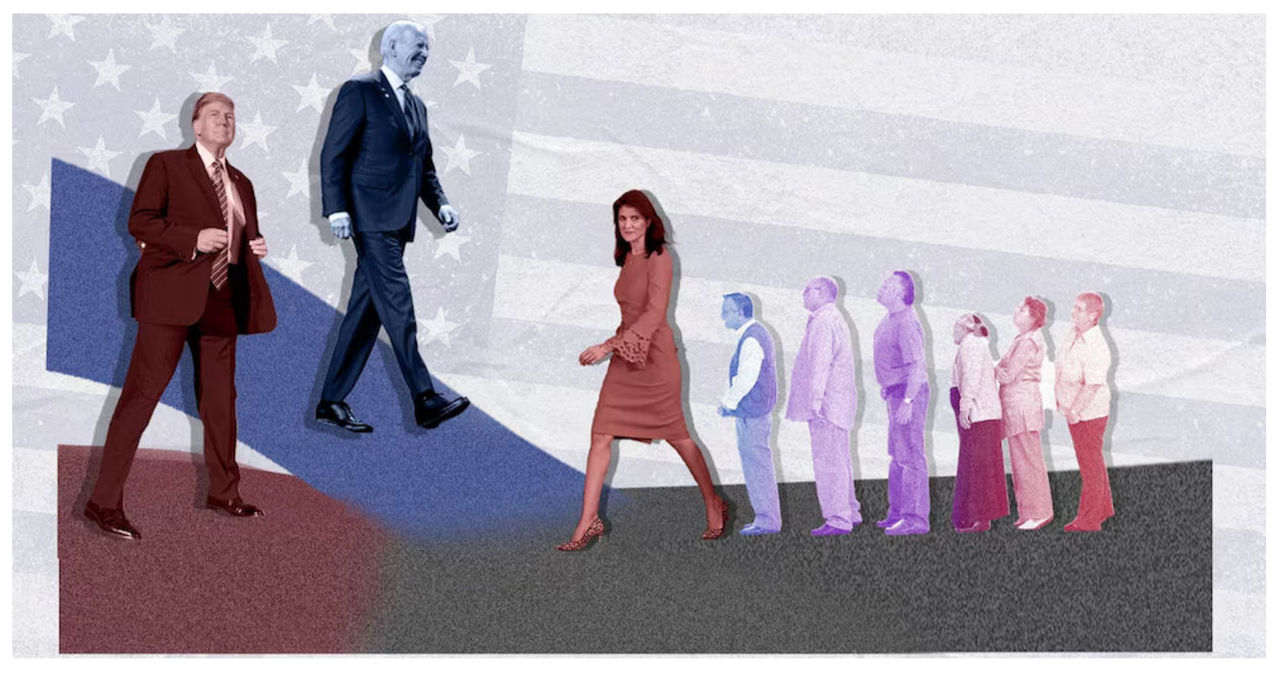The Rolling Stones’ “You Can’t Always Get What You Want” has been a beloved campaign theme song for former President Donald Trump for a long time. However, now that he has secured the Republican presidential nomination, it might be time for his campaign to switch to another late ’60s tune: The Beatles’ “Come Together.”
There has been much discussion regarding whether supporters of former U.N. Ambassador Nikki Haley will back Trump in the upcoming election. Initially, there are indeed some warning signs for Trump. Exit polls on Super Tuesday in California, North Carolina, and Virginia revealed that between 80 percent and 95 percent of Haley’s primary voters in these states would be “dissatisfied” if Trump were to win the nomination. Additionally, an early March survey conducted by Emerson College indicated that 63 percent of Haley’s supporters would prefer President Joe Biden over Trump in a general election matchup, while only 27 percent favored Trump.
The possibility of Republican support rallying behind Trump does not solely depend on his efforts to win over Haley voters. Historical election results indicate that a significant number of Haley’s supporters will eventually align themselves with Trump. This is particularly true for self-identified Republicans and independent voters who lean towards the GOP, as they are highly likely to support their preferred party’s nominee. However, it is probable that some of the more moderate independent supporters of Haley may not ultimately back Trump. Nonetheless, it is important to note that many within this substantial group were unlikely to vote for Trump from the beginning, which is a recurring pattern in recent nomination races.
Many Haley voters were unlikely to ever vote for Trump
It is important to exercise caution when interpreting Nikki Haley’s performance and its implications for potential divisions within the GOP. While there has been considerable discussion about Haley voters and the upcoming general election, it is crucial to consider the bigger picture. In the current election cycle, Donald Trump has secured an overwhelming 72 percent of the Republican primary vote, whereas Haley’s share stands at a mere 24 percent. This clearly indicates that Haley’s supporters represent a minority within the GOP primary electorate.
Furthermore, only approximately half of Haley’s voters identified themselves as Republicans, whereas the remaining portion identified as independents or even Democrats, based on available exit poll data. Consequently, it becomes evident that a significant portion of Haley’s supporters were inclined to vote for Biden rather than Trump in a general election from the outset, based on their party affiliation, ideological perspectives, and attitudes towards Biden. In contrast, Trump’s primary voters more closely align with the overall composition of the GOP in terms of party identification and conservative viewpoints.
Party identification is a revealing factor when it comes to predicting voter support in the general election. In the six states of California, Iowa, New Hampshire, North Carolina, South Carolina, and Virginia, where entrance and exit poll data is available, we find that less than half of Haley’s voters identified as Republicans, while a significant 73 percent of Trump’s supporters were Republicans. On the other hand, 41 percent of Haley’s supporters, compared to 27 percent of Trump’s supporters, identified as independent or affiliated with another party. Interestingly, about 11 percent of Haley’s primary voters in these states, in contrast to almost none of Trump’s voters, identified as Democrats. It is worth noting that this group will mostly support Biden in the upcoming November elections.
Based on their ideological views, we can infer a notable difference between the independent voters who supported Trump and those who voted for Haley. While the exit polls did not provide data on which party these independent voters leaned toward, an analysis of their beliefs reveals interesting insights. In the six states under consideration, it is evident that a majority of Trump independents (71 percent) identified as conservative, suggesting a leaning towards the Republican party. On the other hand, the majority of Haley independents (67 percent) identified as moderate or liberal, indicating a more diverse political affiliation. It is important to note that while there were very few liberal-leaning independents, it is likely that a significant portion of the Haley independents who identified as moderate instead of conservative may align themselves with the Democratic party. This highlights the presence of Democratic-leaning voters among the group of independents who supported Haley.
The approval rating of Biden among the voters of Haley and Trump offers additional proof that Haley enjoyed substantial support from Democratic-leaning voters who took part in the Republican primary. According to the exit polls from California, North Carolina, and Virginia on Super Tuesday, 40 percent of Haley supporters expressed approval of Biden’s performance as president, in contrast to just 1 percent of Trump voters. Moreover, nearly half of the independent Haley backers in those three states gave their approval to Biden.
The approval rating among Haley voters is impressively high, considering that only around 10 percent of Republicans and approximately 30 percent of independents approve of Biden’s job performance, based on a basic polling average.* In comparison, over 75 percent of Democrats approve of Biden. This indicates that a significant number of independent (or Democratic) voters who support Biden also voted for Haley in the primaries. Importantly, this does not necessarily imply a shift away from Trump for these voters. Recent surveys conducted by Emerson College and Siena College/New York Times reveal that a majority or plurality of Haley supporters actually voted for Biden in the 2020 election.
Biden’s approval ratings can provide insight into the possibility of Republican voters who support Haley switching sides and voting for Biden in the upcoming election. According to exit polls in the three Super Tuesday states, only 25% of these Republicans approved of the current president’s performance. While this percentage is higher than the national average among Republicans, it still indicates that the majority of them will likely stick to their party identification and vote for Trump, even if they are not fond of him, as they also have reservations about Biden.
What past primaries say about breaking with the party
Looking at the characteristics of Trump and Haley primary voters, we can analyze past primary data to understand which voters tend to remain loyal to the party’s nominee and which voters tend to switch sides in the general election. In 2016, both parties had highly contested primaries that strained support for the eventual nominees. This information is based on the 2016 Cooperative Election Study, a comprehensive survey conducted by Harvard University in collaboration with YouGov, which included over 50,000 participants who voted in both the primary and general elections. The chart below illustrates that a significant portion of primary voters who initially supported Bernie Sanders in the Democratic primary, or Marco Rubio and John Kasich in the Republican primary, ended up voting for the nominee from the opposing party.
While we should not consider these specific estimates as absolute truth, other survey findings may differ to some extent. However, according to the CES data, it suggests that approximately 1 in 10 Sanders voters ended up voting for Trump. Similarly, a similar portion of Rubio voters supported Hillary Clinton, the Democratic nominee. What is even more remarkable is that around one-third of Kasich voters switched to voting for Clinton in the November election. It is important to note that Sanders had a larger sample size, as he received a significant number of primary votes during a contest that lasted until June 2016, whereas Rubio and Kasich dropped out in mid-March and early May of that year, respectively.
According to the CES data, it is possible that there were a significant number of Sanders-Trump voters in Michigan, Pennsylvania, and Wisconsin. In fact, the number of these voters may have been greater than the final general election margins in these states. However, it is important to consider other factors such as Kasich-Clinton and Rubio-Clinton voters, which would complicate the calculations if we had enough data at the state level.
Many of the Haley voters this year, as well as a significant number of Sanders, Rubio, and Kasich voters, were not inclined to vote for their party’s eventual nominee from the start. It is worth noting the party affiliation of primary voters who supported these three candidates in 2016 compared to their choice in the general election. A considerable portion of primary voters who supported a candidate from the opposite party had an affiliation with or leaned towards that party. On the other hand, those who remained loyal to the party they voted for in the primary overwhelmingly identified with or leaned towards that party.
The numbers suggest that the majority of Haley primary voters, who identify as or lean Republican, are likely to support Trump in the November election. Interestingly, over 90% of Sanders primary voters who eventually voted for Clinton were affiliated with or leaned towards the Democratic Party. In contrast, less than half of the Sanders supporters who voted for Trump shared the same affiliation. Similarly, a significant portion of Rubio and Kasich primary voters who ultimately voted for Trump were Republicans or GOP leaners. However, only about two-thirds of Rubio-Clinton voters and two-fifths of Kasich-Clinton voters identified with or leaned towards the GOP. It is important to note that these individuals who deviated from their preferred party’s nominee constituted a small minority of the party’s primary voters.
In addition to the aforementioned voters, each of these three candidates, much like Haley, garnered support from a significant number of independent voters and those who leaned towards the opposing party. These voters were already less likely to support the eventual nominee of their primary party. Although it’s not a direct comparison, Kasich’s performance in 2016 appears to align with the findings of the 2024 exit polls regarding Haley’s supporters. Notably, a striking 40 percent of Kasich-Clinton voters identified as Democrats or leaned towards the Democratic party. It’s not surprising, then, that approximately one-third of all Kasich voters ended up backing Clinton in the November 2016 election. Clearly, a substantial portion of the Democratic-leaning voters who participated in the Republican nomination race that year chose Kasich, who remained in the GOP contest for a month and a half longer than Rubio.
According to the exit poll numbers, it is evident that many moderate voters in the 2016 primary who voted in the general election had Democratic-leaning tendencies. This is supported by the fact that half of Kasich voters described themselves as moderate, and a significant majority of them (51 percent) ended up voting for Clinton, while only 36 percent voted for the Republican candidate. Similarly, one-third of Rubio’s voters identified as moderate, and the majority of them (55 percent) chose Trump as their candidate, with 30 percent voting for Clinton. It is worth noting that the remaining moderates in both cases largely supported Libertarian Gary Johnson.
In 2016, Trump shook up the political landscape by attracting more white voters without a college education to the Republican Party, while driving many college graduates towards the Democrats. It is estimated that around 6.7 million Trump voters had previously supported Democratic President Barack Obama in the 2012 election, while approximately 2.7 million Clinton voters had previously backed GOP nominee Mitt Romney. This suggests that some voters’ party affiliation may have been in flux during that year. Despite this, it is clear that many voters who were unlikely to support Clinton in the general election ended up voting for Sanders in the primary, while those who were unlikely to support Trump in November voted for candidates like Rubio and Kasich. Interestingly, the combined vote share of Rubio and Kasich in the 2016 primary states on Super Tuesday closely mirrored Haley’s vote share in the 2024 GOP contest, with a strong correlation of 0.89.
The Importance of Regular Exercise for Mental Health
Regular exercise is not just beneficial for physical health, but it also plays a crucial role in maintaining good mental health. Engaging in physical activity has been shown to have a positive impact on our mood, reducing symptoms of anxiety and depression.
Exercise stimulates the release of endorphins, also known as “feel-good” hormones, which can improve our overall sense of well-being. These endorphins act as natural painkillers and boost our mood, making us feel happier and more relaxed.
Moreover, exercise can help reduce stress levels. When we engage in physical activity, our body releases stress hormones like cortisol. Through regular exercise, we can effectively manage these stress hormones, leading to a reduction in stress and anxiety.
In addition to its immediate effects on mood and stress, regular exercise can also have long-term benefits for mental health. Engaging in physical activity can improve our self-esteem and boost our confidence. When we set and achieve fitness goals, we feel a sense of accomplishment, which can have a positive impact on our self-worth.
Exercise also provides us with an opportunity for social interaction and connection. Whether it’s joining a sports team, attending a fitness class, or simply going for a walk with a friend, exercising with others can help combat feelings of loneliness and isolation.
Furthermore, regular exercise has been shown to improve cognitive function and memory. Physical activity increases blood flow to the brain, stimulating the growth of new brain cells and enhancing brain function. This can lead to improved concentration, better problem-solving skills, and a sharper memory.
It is important to note that exercise does not have to be intense or time-consuming to reap these mental health benefits. Even moderate-intensity activities like walking, swimming, or gardening can have a positive impact on our mental well-being.
In conclusion, regular exercise is not only essential for physical health but also plays a crucial role in maintaining good mental health. By stimulating the release of endorphins, reducing stress levels, boosting self-esteem, providing social connection, and improving cognitive function, exercise can significantly improve our overall well-being. So, make an effort to incorporate physical activity into your daily routine and experience the positive effects on your mental health.
Biden, on the other hand, has proven his ability to unite his party and gain support from fellow Democrats. While we lack extensive data on the 2020 Democratic primary, there are indications that a majority of voters who initially backed Biden’s opponents ultimately rallied behind him as the party’s nominee. In a June 2020 survey conducted by Siena College and The New York Times, it was revealed that 96 percent of Elizabeth Warren supporters, 92 percent of Pete Buttigieg supporters, and 87 percent of Bernie Sanders supporters expressed their intention to vote for Biden in the general election.
It is hard to determine whether this implies a greater sense of unity among 2020 Democrats compared to 2024 Republicans. However, considering the voting patterns of voters who align with or lean towards a particular party, it is a reasonable assumption that by June 2024, the majority of Republicans and GOP-leaning independents will support Trump.
Biden and most Democratic-leaning voters could also be experiencing a similar situation. Despite facing no significant competition for his party’s nomination, with him winning approximately 86 percent of the primary vote this cycle, there has been a notable percentage of voters, between 10 and 20 percent, who have opted for “uncommitted” ballot options in Michigan, Minnesota, and North Carolina in recent weeks. This suggests a certain level of dissatisfaction with Biden among these voters.
However, we must exercise caution in drawing conclusions about the unity or division within the GOP electorate based solely on the Republican primary vote. Similarly, it would be unwise to overanalyze the vote returns from the Democratic presidential primary, which saw low turnout and lacked significant competition. Instead, a more insightful perspective can be gained by examining the polls. These polls reveal that Biden currently holds an approval rating of 38 percent and is only slightly behind Trump in general election polls.



